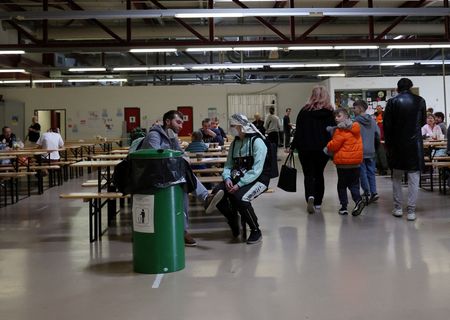By Libby George
VIENNA (Reuters) – Eastern European nations confronting a plethora of economic threats fuelled by war on their doorstep may face fresh pressure if peace is reached in Ukraine – from tight labour markets that fuel inflation thanks to an exodus of Ukrainian workers.
Central and eastern European countries are home to a large proportion of more than 4.3 million Ukrainians who fled to the EU in the wake of Russia’s invasion and have filled jobs amid historically low unemployment levels.
Their possible return to Ukraine after a peace deal is reached would be a snag in what is otherwise good news for the region.
“Demography is a risk, and it’s one that a resolution of the war in Ukraine will make worse, because some of those Ukrainians will go back home,” Charlotte Ruhe, managing director for Central and South Eastern Europe at the European Bank of Reconstruction and Development said at the Invisso Central and Eastern European Forum in Vienna.
Incoming U.S. President Donald Trump’s pledge to end hostilities between Russia and Ukraine when he takes office on Jan. 20 has prompted many to begin considering a post-war future. However, it is unclear how he plans to achieve this and his advisors have conceded a peace deal is months away.
Economic growth across central and eastern Europe was 2.2% last year, Raiffeisen Bank International estimates — faster than the stagnant 0.8% it predicts in the euro zone.
DRIVING EXPANSION
Ukrainian workers – who gained legal rights to live and work in Europe via a March 2022 European Union directive – aided this dynamism, helping the region’s manufacturing and export-driven economies expand quickly.
Of the 4.3 million people who fled Ukraine for the EU by December 2023, 22% of them were in Poland and roughly 9% in the Czech Republic, Eurostat data showed.
“Part of the economic success in many countries is linked to Ukrainians who moved there over the last two years,” Christian Petter, head of Austria and CEE with J. Safra Sarasin, said at the summit.
“Now, with the war hopefully being finished, of course, there is a big chance that these people will return to Ukraine and [leave a gap in] labour markets like in Prague, in Bratislava, in Warsaw, and will be a challenge to be replaced.”
The region faces other, bigger, headwinds.
Growth in several countries – notably Hungary – has centred around manufacturing and exporting, including car parts, thanks to the region’s comparatively affordable workforce.
UNCERTAINTY OVER TARIFFS
Potential trade wars, spurred by Trump’s tariff promises, complicate this model as government debt remains elevated.
Poland, Romania and Slovakia’s debt-to-GDP ratios could continue to climb, according to Erste Group. Poland’s deficit-to-GDP last year – bloated by defence spending – stood at roughly 5% of GDP, above the EU’s 3% target.
A loss of workers would add to pressure.
In November, Poland’s central bank published a survey of Ukrainian migrants, showing that while just 2% of refugees and 1% of pre-war migrants wanted to go back to Ukraine in less than a year, those figures would jump to 59% and 34%, respectively, if the war were to end.
Unemployment in Poland stands at all-time lows, pushing wage growth to peak last year at 10%.
The Czech government has warned that looming labour shortages threaten its economy, a trend mirrored in other countries in the region.
Rising wages and inflation make it harder for central banks to cut interest rates, and sticky inflation and a rising U.S. dollar have already challenged the current rate-cutting cycle in eastern Europe.
Keeping rates higher for longer pressures economies and makes local debt more expensive for governments.
Raiffeisen Bank International head of research Gunter Deuber said falling inflation was not a given, and its pace was likely to remain static in Hungary and Romania, while climbing in countries including the Czech Republic.
“This means we don’t expect too big of rate cuts coming in our region,” he said.
THREATS ABOUND
Still, Deuber was sceptical that Ukrainian workers who had established themselves would really leave, particularly given uncertainties around a possible peace deal.
The EBRD’s Ruhe emphasized that companies could use departing workers as an opportunity to invest in labour-saving engineering measures.
Bankers and investors said post-war Ukrainian reconstruction efforts could be a boon for neighbouring countries, particularly Poland.
But Trump’s return to the White House – and the dollar strength, tariff threats and uncertainty it will bring, along with deteriorating faith in U.S. Federal Reserve rate cuts – make for a challenging mix for policy makers.
“Threats are everywhere,” Ana Tripovic, state secretary in Serbia’s Ministry of Finance, told the summit.
She noted that COVID-era debt increases and the energy crisis prompted by Russia’s invasion of Ukraine, were now compounded by the strong U.S. dollar, making it more expensive for countries like hers to service international debt.
“The market work is getting more and more complicated,” she said. “Today … we are facing all those threats and challenges that happened years apart.”
(Reporting by Libby George, additional reporting by Karol Badohal in Warsaw and Gergely Szakacs in Budapest; Editing by Karin Strohecker and Bernadette Baum)












